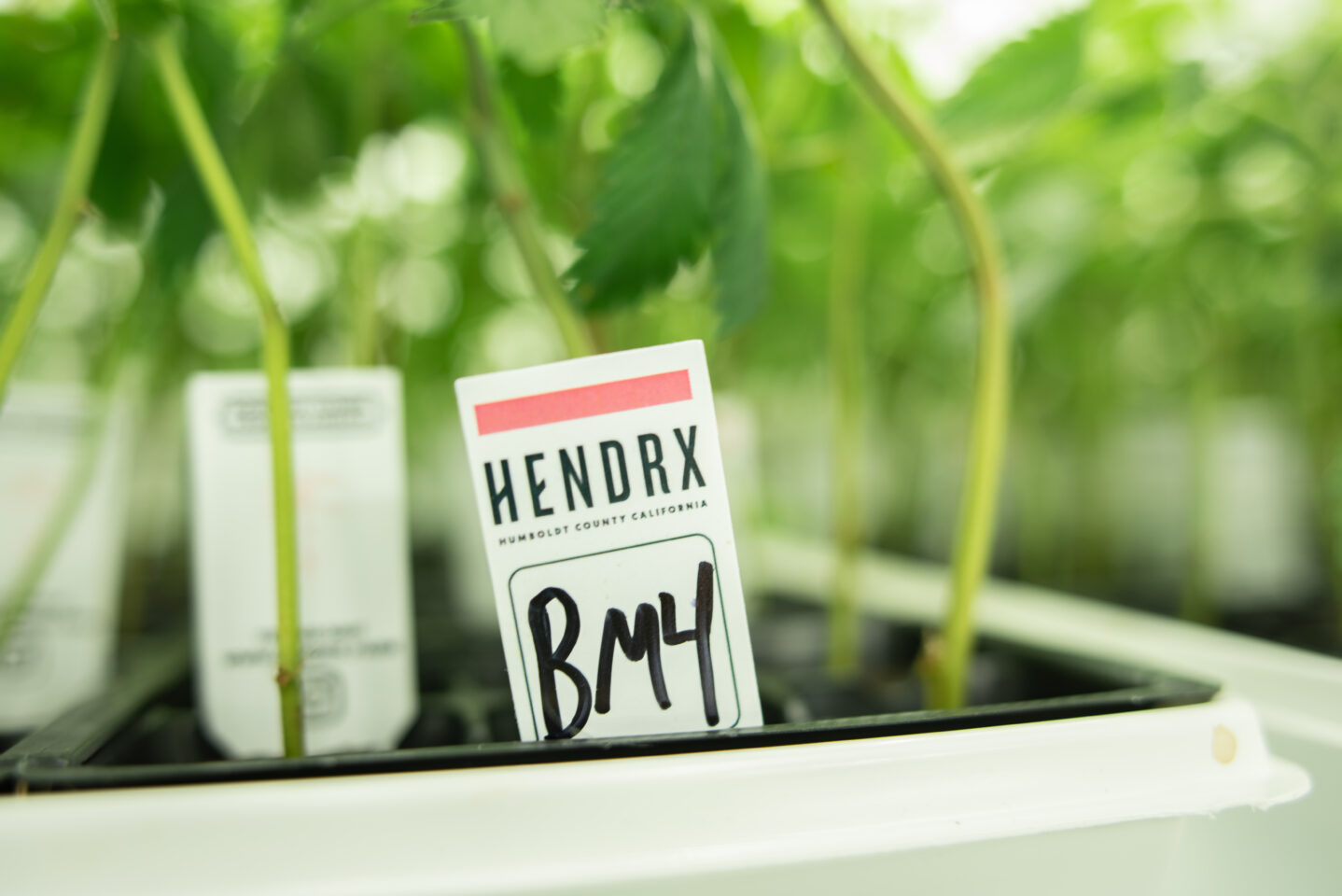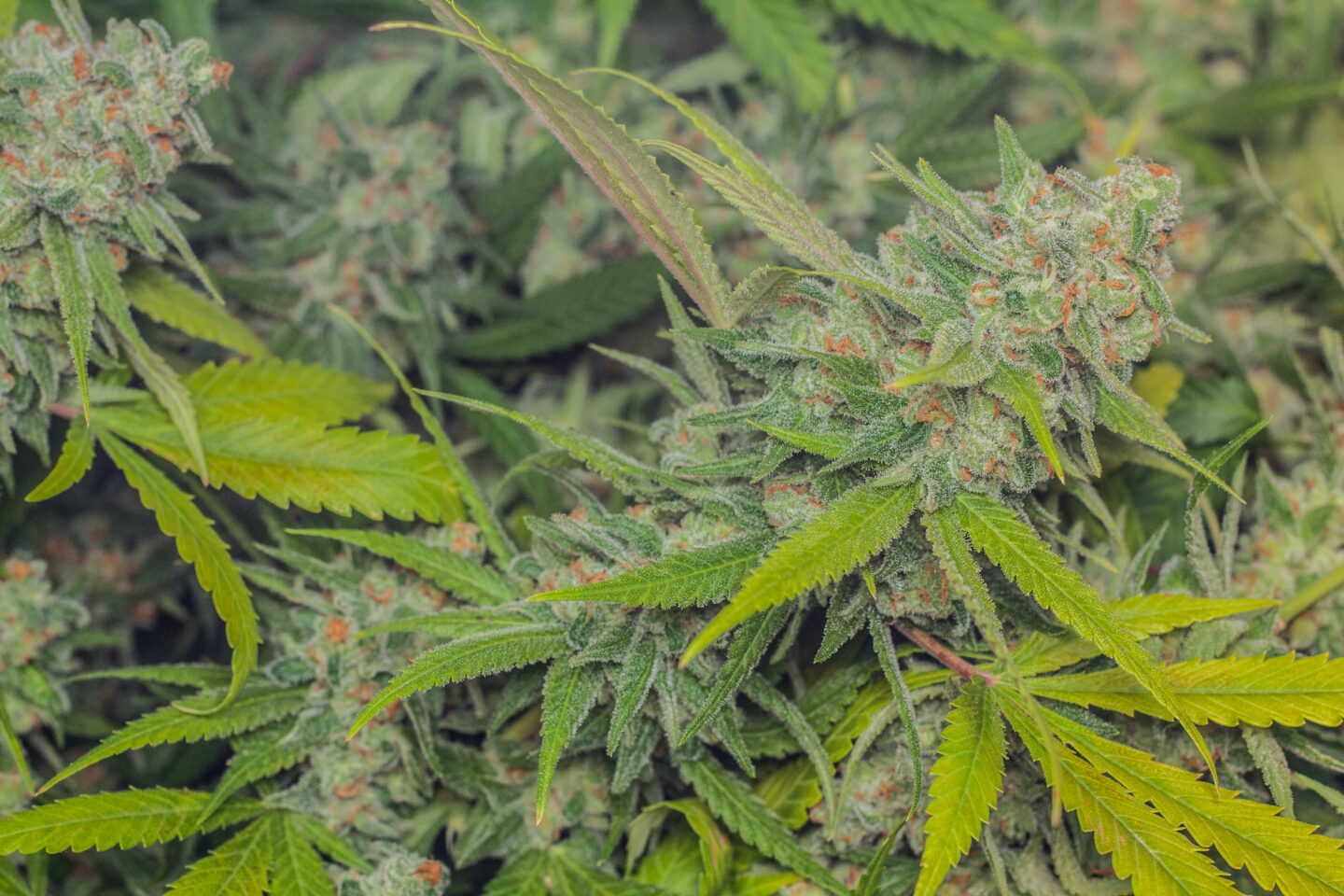Up in California’s Emerald Triangle, just north of Cal Poly Humboldt and nestled between the Mad River and a community forest, HendRx Farm is a commercial nursery dedicated to cataloging the community’s work with the cannabis plant. What started as a simple 400-square-foot operation now spans almost 10,000 square feet across multiple locations, keeping around 200 varieties of clones at a time in their catalog and serving farms across California. Together, Daniel Hendricks, Jeff Schirmann, and David Lunsford have built a resource where the preservation of plants is paramount. The calling at HendRx Farm is to create a viable source for farmers to secure not only the clones that are high value right now, but also the ones that helped put this whole game together, strains like Ringo’s Gift, Arcata Trainwreck, or Skunk #1. HendRx believes the mission to procure and hang onto these culturally-significant cultivars is not just a community service but a responsibility. Every sprout has a story to tell, and HendRx is helping to assemble the Criterion collection.
I spoke with Hendricks while he was getting started on the clone selections for the next few growing cycles.
“With an operation like this, juggling orders for so many farmers, you have to be seasonally minded,” he said.
The company started in 2014, but for Hendricks, his days of growing can be traced back to the ’90s. Having grown up in Humboldt, he was attracted to cultivation and breeding early on, eventually finding companions who shared his enthusiasm for weed. Hendricks, Schirmann, and Lunsford bonded over the belief that a person has a right to farm, as well as a mutual thirst to learn the history of the cannabis strains that had proliferated throughout the West Coast. Together, the group became known for helping authenticate strains for growers.

“We were good at validating if something was the real version of what you were after,” Hendricks said.
In 2016, they chose to file as an official nursery after deciding it was not only what matched their shared passion but also what they felt the legal cannabis community needed most. Hendricks chuckled while describing their first setup.
“It was this tiny little square box that was barely big enough for all of us and the plants,” he said.
Today, they’ve developed that passion into a large-scale, thriving business that includes the launch of their genetic preservation library, where they authenticate, stabilize, and store cultivars that the community has deemed essential. Half of their main building is dedicated to this breeding project. The goal is to get up to 80 strains in the library, all independently bred, stabilized, and preserved through clones. Attaining this goal, Hendricks said, is in no small part thanks to their partner farms like SoHum Seeds and Hidden Prairie Farms, which grow these strains out and help them develop phenotypes for possible production.
“We rely on them for so much, in terms of testing the product by growing and smoking it, but hearing their stories about how it grew, seeing all the effort and coordination from around the community, that’s undoubtedly the most fun part,” he said.
It’s that feeling of community responsibility and respect that put HendRx in the unique position to preserve and become stewards of the famous CBD strain, Ringo’s Gift. Hendricks spoke about how this incredible story shows how the breeding and nursery community can work together to make sure something doesn’t disappear once the spotlight fades away.

The Gift That Keeps on Giving
After cannabis breeder Lawrence Ringo’s passing in 2014, Hendricks was at a memorial service in Mendocino, where he heard Samantha Miller from Pure Analytics Lab talk about the first time they discovered the presence of CBD in Ringo’s Gift. She described how everyone on the call afterward was cheering and laughing and how inspired everyone felt. The HendRx team knew they had to hunt and find the seeds so they could, in some small way, do their part to honor this work. They worked tirelessly to find two variations of Ringo’s Gift, eventually called Katie’s Cut and Levi’s Cut.
After a lot of calls and messages, they managed to procure a hemp-compliant clone hunted to help treat the mother of a local client named Katie. Then, with the aid of Purple Caper Seeds (creators of the Chocolate Hashberry), the HendRx team was able to get their hands on a cut that had been given to Purple Caper by Ringo’s son, Levi Lawrence, in a parking lot in San Jose, California years prior. This cut, now known as “Levi’s Cut,” was another key part of HendRx’s efforts. Armed with two versions of the plant, they went to work. Hendricks started making 1:1 hybrids while Schirmann began to stabilize it with a hemp variety, and then the calls started flooding in.
People had heard about what they were doing and wanted to get their hands on this important medicinal strain to give to their friends. Among these calls were Levi and Danielle Lawrence, who then operated SoHum Seeds. After giving this strain back to Ringo’s family, to the very person who had handed over this cut in a parking lot years earlier, HendRx felt they had really achieved something important for the nursery community. Levi and Danielle Lawrence eventually chose Jerry Savage to operate SoHum Seeds to continue the Ringo’s Gift legacy, and Savage invited HendRx to be part of that mission. Today, HendRx manages facilities at SoHum Seeds in Whitethorn, California, where they operate an R&D section, along with garden space for Savage Farms.
After successfully working with the Ringo’s Gift through breeding and experimentation, Hendricks figures they’ve successfully created at least 50,000 Ringo’s Gift plants over the last two years.
“It’s definitely the most important clone we have, and it’s at the ethos of what HendRx does: preservation,” he said.
When it comes to the concept of cannabis and legacy, Hendricks said that they prefer to use the term “heirloom” when referring to their work since it “better holds the reflection of what these strains are: plants with a rich position in history and a huge potential value to the future.” For them, these plants haven’t yet finished writing the legacy they will leave behind. Part of their daily mission is ensuring these heroic varieties make it to the final battle. To Hendricks, “legacy strains,” as the term pertains to retail cannabis, are too expensive to keep alive in today’s market, given the current profit margins. This makes preserving genetics paramount to ensuring we don’t lose what we already have, as people today are planting less of the classics like San Fernando Valley OG and newer strains like Lemon Cherry Gelato.
“Preserving these strains ensures these plants don’t just leave behind a legacy, either because they stay valuable to the community or to the retail market,” Hendricks said. “It’s our duty to the community to preserve what the industry won’t save.”

The Oxford English Dictionary definition of heirloom, in reference to plants, refers to a variety that is not associated with large-scale commercial agriculture. Hendricks referenced how the inherent value in these strains isn’t just in their flavor, historical importance, or medicinal value but also in the untapped intellectual property value the industry has left on the table. If a brand figures out how to adapt an heirloom strain for scalable cultivation and makes it a flagship product, especially one that’s part of their company mission to give back to cannabis, then that in and of itself is a valuable brand identity that’s empowered by that cultivar. In a way, that’s part of the work HendRx is doing, along with The Humboldt Legacy Project on the famous cannabis strain Skunk #1. After being procured by David Watson and preserved by Marty Yip of Sensational Solutions, HendRx was entrusted with the Skunk #1 to work with. Together with the Humboldt Legacy Project, they’ve already started testing something they’re calling the HLP Skunk #1 No. 1 or HLPS1.
Currently, HendRx is in the second round of tester gardens grown through their partners in the project, MOCA Humboldt, which took home nine awards for their cannabis at the 2023 California State Fair. Hendricks remarked how together they are isolating possible production candidates like this HLP Skunk #1 No.1 but explained that the process is still a while away from a batch of clones being considered for retail because “some of these [plants] need commercial work and are perhaps unattainable under our current framework.” He went on to explain how the time and supplies required to grow a difficult heirloom strain, or something that takes 14 weeks or longer to finish up, often outweighs the possible return on investment, making them a harder sell during planting season.
“Things like this require a big price tag in order to break even,” Hendricks said. “Growing a field of something like Trainwreck really needs subsidized farming.”
Despite these concerns over sustainability in the current retail market, they were able to release a small amount from the first test garden to the public, including a survey created by HLP and HendRx that asks smokers for their feedback. Hendricks says the staff at MOCA Humboldt are all hyped about having this opportunity and someday being able to offer a product with an unbelievable history and proven provenance for smokers who want to try that old-school ’90s weed.

How a Strain Gets Its Library Card
What does it take for a strain to end up in HendRx’s genetic preservation library? The answer to that is both simple and complex.
“It has to pass the three wise men,” Hendricks said, meaning all three owners of the nursery have to look at each case and approve it, but there are a few factors that majorly contribute to the decision. Cost is an important factor. It takes around $1,200 a year to keep a single strain stored away. Hendricks admits that switching to tissue culture would be a smaller footprint for storing their library, but it would keep things further out of commercial rotation and increase wait times for their farm partners. Another big criteria is space, not just in terms of where to store plants but also how to store multiple cultivars together so that there’s a healthy ecosystem. Inside their Noah’s Ark, everything is operating in a sort of hibernation homeostasis, and there’s always a potential risk involved in bringing them out and back into storage. If a strain can prove itself to have a valuable history, be free of pathogens, and can do well in its storage facility and pass the test for all three owners, then it becomes part of the genetic preservation library.
Hendricks made it clear that the library is about preserving older strains but that recent and current ones aren’t excluded from induction.
“It has to be important, not just cool, and it has to have potential value in terms of research, rarity, terpene breakdown, market value, or education,” he said.
He sees the mission as keeping these cultivars alive for the future, even more so than in the past. They recognize that the new heat and throwback strains from the ’90s might be more in demand than the hits of the ’70s, but that doesn’t mean those flavors don’t contain something super inspiring for the future. The whole thing is a lot like the preservation of music. There are more albums made in a day than you could listen to in a year, so deciding who and what gets preserved is a difficult task that requires a lot of dedication, research, and input from the community, along with a little bit of intuition sharpened by experience. One example he gave is Italian Icee, a strain that has gotten them a ton of positive feedback and is something they had a gut feeling about when it first landed in their hands.

Hendricks explained that it was a rugged, sunbaked German man who approached them. He looked like a guitar tech or a roadie for some band your uncle loves and he said he had something special they needed to keep safe. He came back the next day with a tiny piece of paper that held a pile of seeds and the instructions for his Mason jar technique for germination; all hastily scrawled out like the recipe for a wizard’s potion. It was a gut feeling the guys at HendRx had that led them to keep it. After all, Ice Cream Cake crossed with Blueberry Muffin is nothing to necessarily write home about, but HendRx had a hunch, so they had Royal Lief grow it out and select the pheno: Ice Cream Cake x Blueberry Muffin #4. After that, it traveled to the R&D site at SoHum Seeds, where it languished for a year and a half before a client came asking for an Ice Cream Cake cross. Now, six years after getting that crumbled scrap of paper, Italian Icee has done quite well, a success Hendricks modestly attributes to the strain finding the right home for its story rather than the HendRx team’s gut instinct for sniffing out a winner.
For every success story like this, there are a dozen or more heirloom cultivars waiting to find their voice in this evolving industry. I asked if any of these were becoming in demand with farmers last year in 2023, and Hendricks said that HendRx is getting a lot more requests from people wanting to try their hand at growing an heirloom strain, but producing orders on these cultivars takes a lot of time and labor so there are waitlists for many of the most recognizable names.
“The longest lines are always for Trainwreck, Sour D, and Tangie,” Hendricks said. “But the lines for NF1, XJ13, and GSC are right at their heels.”
Hendricks said his company likes to say the mission ends when you can find Sour D and Girl Scout Cookies in the garden department next to tomato starts and daffodils. The idea is that when they can create and maintain these strains for home gardeners and commercial growers alike, they no longer have to worry about these strains leaving enough of a legacy to be saved from extinction. Until then, HendRx will continue to expand the genetic preservation library to conserve and promote heirloom cannabis.
This article was originally published in the May 2024 issue of High Times Magazine.



















